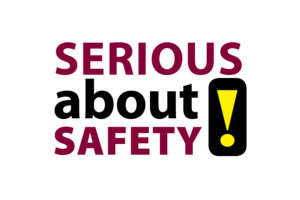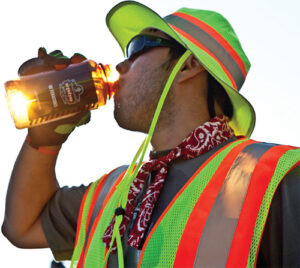
August 2022
The Importance of Hydration during those HOT Summer Months
 One of the major ways of maintaining wellness is by staying hydrated, and there is no drink as hydrating and healthy as water. Although there are important health benefits to drinking adequate amounts of water all year long, when the temperatures rise, it’s especially important. Dehydration occurs when more fluids are lost than are taken in, and the body doesn’t have enough. In order to carry out their normal activities, the cells in the body need water. However, large quantities of water and electrolytes can get depleted through sweating, underscoring the importance of hydration during hot summer months.
One of the major ways of maintaining wellness is by staying hydrated, and there is no drink as hydrating and healthy as water. Although there are important health benefits to drinking adequate amounts of water all year long, when the temperatures rise, it’s especially important. Dehydration occurs when more fluids are lost than are taken in, and the body doesn’t have enough. In order to carry out their normal activities, the cells in the body need water. However, large quantities of water and electrolytes can get depleted through sweating, underscoring the importance of hydration during hot summer months.
There are many benefits to drinking plenty of water including higher energy levels, increased physical performance and quicker recovery. Additionally, staying adequately hydrated can help to avoid the consequences of too little water including headaches, low blood pressure, lightheadedness, a dry mouth, dry eyes, constipation, and concentrated urine. Even low levels of dehydration can cause some of these issues. Fortunately, most instances of dehydration can be resolved by merely increasing the intake of fluid.
Dehydration can happen to anybody, but some people are more at risk. Along with people who have special health issues such as those with heart or kidney issues, athletes, the elderly and young children are especially at risk. Older adults can have changes in the brain which may mean that thirst may not always occur. Children can be at risk for dehydration when they are outside playing. It’s important for everyone, but especially these groups, to make time for scheduled water breaks.
Generally, thirst is an important indicator when hydration is needed. Yet, by the time thirst is recognized, dehydration may already be a factor with some cognitive impairment involved. Recent research indicates that exactly how much water is dependent on physical activity levels and temperatures. When there’s heavier exercise or higher heat, more water is lost.
This summer, remember that it’s vital that your whole family has access to clean, pure water. A whole home water filtration system can improve the taste and odor of drinking water and encourage the whole family to stay hydrated with delicious, pure, clean water.
Employee’s Hydration
 How Much Hydration Is Enough?
How Much Hydration Is Enough?
Water is an essential nutrient for all living things. It makes up 70 percent of planet Earth and 60 percent of our bodies. It keeps us functioning at optimal performance levels by regulating our core body temperature, carries key nutrients to vital organs and flushes internal toxins. We simply cannot survive without it.
Whether walking to your car or performing a strenuous task at the jobsite, your body is always working to maintain a balance and sustain its core temperature. And because our bodies are constantly exposed to elements that increase body heat and deplete hydration levels, workers must be extra careful when working in extremely hot or extremely cold conditions. Not only do extreme temperatures take a toll on the body, they make workers way more susceptible to becoming dehydrated. Symptoms of dehydration include:
- Thirst
- Fatigue
- Muscle cramps
- Nausea, dizziness or confusion
- Excessive perspiration
- Hot, dry skin
Serious risks are associated with dehydration, including a heat-related illness. The HRI spectrum can range from heat rash to heat stroke and even death. So, how much hydration is enough?
As a general guideline, the recommended amount of water intake is one quart per hour of active work or exercise for the average adult. That is the equivalent of 128 ounces (3.78 liters) every four hours at minimum. It is also suggested that the water intake be distributed over a period of time, such as every 15 minutes per shift.
However, every worker is different. The exact amount of hydration intake depends on the individual. It’s important to consider the following factors:
- Do any underlying health conditions exist? Older individuals and those who suffer from conditions such as high blood pressure, diabetes and heart disease have different hydration requirements. Taking medications can also alter the body’s tolerance to environmental factors.
- What is the level of physical exertion? As the body performs a task, even a basic one like breathing, it loses hydration.
- What type of environment is the work being performed in? HRIs are not exclusive to outdoors as some may think. Many indoor workers are exposed to extreme heat, leaving them susceptible to dehydration and heat stress.
- Is the temperature hot? Is there radiant heat coming from machinery and other power sources? If the answer to either of these is yes, then it is very likely that any workers nearby are managing the heat by sweating – and therefore losing moisture. These individuals will need more fluid replacement.
- Is the environment new to the individual? The human body is very capable of adapting to its environment but time and acclimatization is required in both hot and cold environments.
Above all, prevention is key to minimizing the risks associated with the effects of dehydration. An employer should consider implementing the following simple strategies to promote hydration in the workplace:
- Have water easily and readily available.
- Provide incentives such as reusable water bottles and/or hydration packs.
- Set up shelter and enforce breaks for all employees.
- Provide appropriate personal protective equipment to help workers keep their cool.
- Education and training are key to prevention and preparedness.
